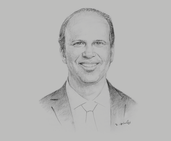Alfredo Rizo, CEO, Terranum Corporate: Interview

Interview: Alfredo Rizo
To what extent has currency depreciation had an impact in terms of foreign investment?
ALFREDO RIZO: Prior to the currency depreciation, Colombia looked expensive, and several investors started to have concerns about prices. Therefore, the current value of the peso is a good entry point for foreign capital to invest in the real estate market. Foreign investors have minimal exposure to Colombian real estate, and new capital should enter the market in the coming years as the market becomes more institutionalised.
One of the limitations foreign investors have faced in the past is limited scale and quality of institutional opportunities. Nevertheless, in recent years several local players have been able to attract foreign capital as they have acquired or developed premium real estate assets and strengthened their corporate governance standards. Recognised international players have invested in the country in recent years, which shows an existing appetite for investment. The arrival of additional foreign capital should contribute to the sector’s growth and dynamism; however, this capital will have to compete against local institutional players who have also been aggressively increasing their capital allocation to real estate, as the asset class still comprises a very low portion of their investment portfolios.
How competitive is Colombia’s financing market, and how can longer-term financing be promoted?
RIZO: Colombia’s real estate financing market has improved over the past decade; however, it continues to be expensive relative to other countries in the region such as Mexico, Peru and Chile, where long-term interest rates are lower in both the mortgage and commercial markets. It is important to note that until a few years ago long-term financing was not available for commercial real estate projects. Now that long-term financing is available for such activities, several local players have developed large, high-quality assets for lease, similar to what happens in developed countries.
Additionally, if inflation returns to levels around 3-4%, which is expected in the near future, it is very important that banks have access to more long-term funding with attractive terms. This will allow them to offer better conditions to developers. Such long-term funding should come primarily from bond issuance, with inflation-linked rates mainly financed by pension funds and insurance companies. Going forward, developers should also be able to access the bond market, which would improve the terms and cost of financing.
What factors are driving demand for residential real estate, and what variations exist across the different income segments?
RIZO: Colombia has one of the highest housing deficits in the region. The growth in the number of households continues to exceed annual supply of housing, which represents an investment opportunity. Demand has been driven by a growing middle class, lower unemployment, better access to mortgage financing and government incentive programmes.
The housing market remains strong and is one of the key drivers of the Colombian economy. The number of units sold grew by 5.8% in 2015. Although the upper segment has shown signs of deceleration in 2016, affordable and middle-income housing continues on a positive trajectory. This is mainly the result of the incentive programmes launched by the government through interest rate subsidies. The middle-income segment showed positive results, with units sold increasing by 13.9% year-on-year in the first quarter of 2016. In December 2015 the government announced an investment of COP1.22trn ($366m) for 122,500 new housing subsidies directed to low-income households.
Access to mortgage financing has also contributed to housing market growth. Mortgages outstanding increased from 3.2% to 5.8% of GDP from 2008 to 2015; however, this is low relative to other countries in the region. A deeper mortgage market remains critical.
You have reached the limit of premium articles you can view for free.
Choose from the options below to purchase print or digital editions of our Reports. You can also purchase a website subscription giving you unlimited access to all of our Reports online for 12 months.
If you have already purchased this Report or have a website subscription, please login to continue.

